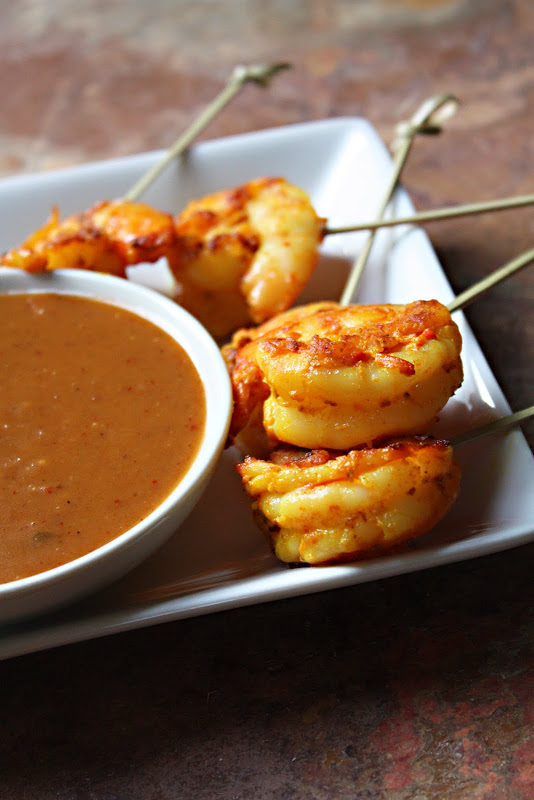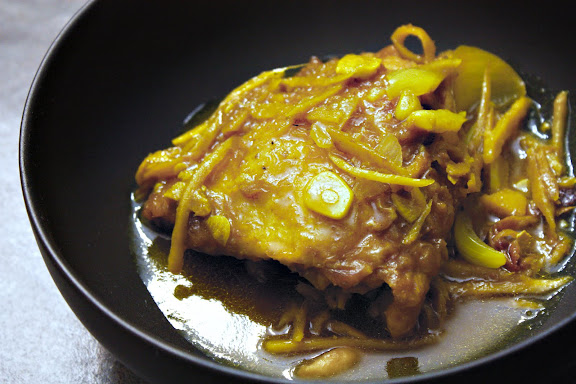
This is somewhat of a scaled-down, cheaters’ version. I’ll soon post the street vendors’ version with both the marinade and the grilling sauce which would be more appropriate for pork or beef satay. I hope this will tide you over until then. It’s a quick recipe, but delicious nonetheless. Continue Reading →
Archive | She Thais RSS feed for this section
Shrimp Satay with Thai Peanut Sauce (สะเต๊ะกุ้ง)
Toasted Rice Powder for Thai Cooking – Khao Khua (ข้าวคั่ว)

In keeping with the simplicity of this ingredient, I’m going to skip my usual rambling and go straight to the instructions on how to make toasted rice powder (ข้าวคั่ว).
However, before we get there, please let me state this. Whenever a Thai recipe calls for toasted rice powder, even just a smidgen of it, don’t be tempted to leave it out. Don’t get me wrong; I am all about shortcuts and convenience as long as the quality is not severely compromised. But when it comes to toasted (sometimes called ‘roasted’) rice powder, in my opinion, it is never optional. This insignificant-looking khao khua is what differentiates a vaguely Thai-inspired dish from what a Thai mother serves her family somewhere in Thailand as we speak.
Not only does toasted rice powder serve as the source of the “nutty,” toasty flavor that defines certain dishes, but, in some cases, it also functions as the binder/thickener/emulsifier/filler/moisture-retainer much like what modified starch does in industrial food applications.
For your convenience, ready-made toasted rice powder is available in many Asian grocery stores, especially ones specializing in Southeast Asian ingredients. But if you can’t find it in the store, you can make toasted rice powder at home in a jiffy. You only need three things to make all this happen: a skillet, a coffee grinder (or a set of granite or glazed terracotta mortar and pestle), and the right type of rice, namely Thai sticky or glutinous rice. Some people say regular long grain rice works just as well, but I disagree. Long grain rice is much more dense than glutinous rice, and while the latter melds seamlessly into the dish, the former tends to create the undesirable gritty texture.
I usually make a small batch—about half a cup of raw rice—at a time to ensure freshness as this is an ingredient I use very little of and not very often. You want to start by setting a skillet over medium-low heat, then add the rice into the skillet and stir and shake every few seconds to make sure the grains are evenly toasted. (Do not be tempted to use high heat to speed up the process, your rice will only be undercooked on the inside and burnt on the outside. And since burnt equals bitter, you don’t want that.)
After 10 minutes or so, the grains will turn medium brown. (They should now resemble brown rice in color.) Remove the skillet from heat and let the rice cool completely. Toasted rice fresh off the stove is very, very hot; I wouldn’t touch it with my hand. Grinding toasted rice while it’s still hot is also a bad idea; it could cause the motor of your coffee grinder to overheat if you choose to grind it in a coffee grinder.
Once the rice has cooled, grind it in a mortar or a coffee grinder, two tablespoons at a time, until a fine powder is achieved. (The texture of pulverized toasted rice should resemble that of stone-ground wholewheat flour — albeit just a tad coarser.) Store your toasted rice powder in an airtight container and keep in the pantry.
Burmese Chicken Stew? Maybe?

The title may be hesitant in tone, but I am saying this with no ambivalence: if you would cook from only one of my recipes, be sure it’s this one.
My maternal grandmother made this stew for us quite often. Back then, all I cared about, sadly, was eating it, not learning how to make it. In contrast to my mother who wrote down more than she should have, Grandma never wrote down any recipes anywhere and, unless I was there when she made certain dishes, I never learned what went into them. My attempt to get a written down recipe from Grandma would have been futile anyway given the way she cooked. I can imagine how our conversation would have gone: Continue Reading →
Enter your email to subscribe:
ARCHIVES
-
 Subscribe to The Epestle to Receive New Posts
June 30, 2021
Subscribe to The Epestle to Receive New Posts
June 30, 2021
-
 Introducing THE EPESTLE
February 13, 2021
Introducing THE EPESTLE
February 13, 2021
-
 Bury Me in Nam Phrik: Mike Sula’s Exploration of Thai Relishes (Plus Salted Soybean-Pork Rind Relish Recipe)
May 1, 2018
Bury Me in Nam Phrik: Mike Sula’s Exploration of Thai Relishes (Plus Salted Soybean-Pork Rind Relish Recipe)
May 1, 2018
-
 Food and Cooking in Thai TV Dramas, Love Destiny, 17th Century Siam, and Crispy Noodle-Wrapped Pork Dumplings
April 2, 2018
Food and Cooking in Thai TV Dramas, Love Destiny, 17th Century Siam, and Crispy Noodle-Wrapped Pork Dumplings
April 2, 2018
-
 A Simple Thai Dipping Sauce
March 12, 2018
A Simple Thai Dipping Sauce
March 12, 2018
-
 Northern Thai Rice Noodle Soup with Pork Ribs, Dried Cotton Flowers, and Tomatoes (Khanom Jin Nam Ngiao)
September 1, 2017
Northern Thai Rice Noodle Soup with Pork Ribs, Dried Cotton Flowers, and Tomatoes (Khanom Jin Nam Ngiao)
September 1, 2017
-
 How to Prepare Rice Vermicelli (Khanom Jin) from Dried Noodles
August 29, 2017
How to Prepare Rice Vermicelli (Khanom Jin) from Dried Noodles
August 29, 2017
-
 How to Prepare Pomelos for Thai Pomelo Salad
May 23, 2017
How to Prepare Pomelos for Thai Pomelo Salad
May 23, 2017










